-
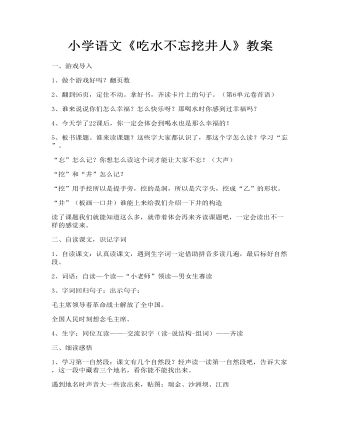
小学语文《吃水不忘挖井人》教案
4、今天学了22课后,你一定会体会到喝水也是那么幸福的!5、板书课题。谁来读课题?这些字大家都认识了,那这个字怎么读?学习“忘”。“忘”怎么记?你想怎么读这个词才能让大家不忘!(大声)“挖”和“井”怎么记?“挖”用手挖所以是提手旁,挖的是洞,所以是穴字头,挖成“乙”的形状。“井”(板画一口井)谁能上来给我们介绍一下井的构造读了课题我们就能知道这么多,就带着体会再来齐读课题吧,一定会读出不一样的感觉来。
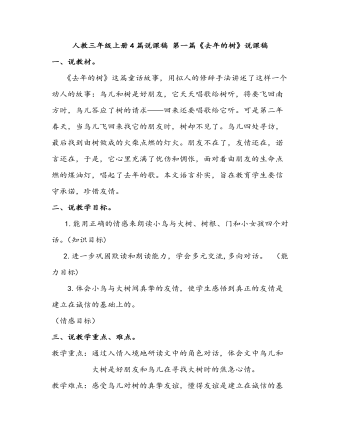
人教版三年级上册语文说课稿
二、说教学目标。 1.能用正确的情感来朗读小鸟与大树、树根、门和小女孩四个对话。(知识目标) 2.进一步巩固默读和朗读能力,学会多元交流,多向对话。 (能力目标) 3.体会小鸟与大树间真挚的友情,使学生感悟到真正的友情是建立在诚信的基础上的。
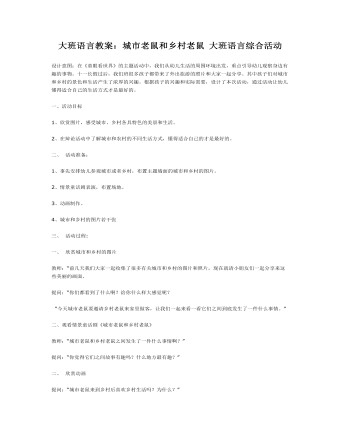
大班语言教案:城市老鼠和乡村老鼠 大班语言综合活动
一、活动目标1、欣赏图片,感受城市、乡村各具特色的美景和生活。2、在辩论活动中了解城市和农村的不同生活方式,懂得适合自己的才是最好的。二、 活动准备:1、事先安排幼儿参观城市或者乡村,布置主题墙面的城市和乡村的图片。2、情景童话剧表演,布置场地。3、动画制作。4、城市和乡村的图片若干张
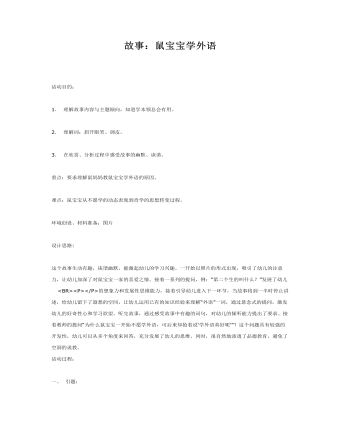
中班语言课件教案:鼠宝宝学外语
2. 理解词:眉开眼笑、调皮。3. 在欣赏、分析过程中感受故事的幽默、诙谐。重点:要求理解鼠妈妈教鼠宝宝学外语的原因。难点:鼠宝宝从不愿学的动态表现到肯学的思想转变过程。环境创设、材料准备:图片设计思路:这个故事生动有趣,诙谐幽默,能激起幼儿的学习兴趣。一开始以照片的形式出现,吸引了幼儿的注意力,让幼儿加深了对鼠宝宝一家的喜爱之情。接着一系列的提问,例:“第二个生的叫什么?”发展了幼儿 <BR><P></P>的想象力和发展性思维能力,接着引导幼儿进入下一环节,当故事将到一半时停止讲述,给幼儿留下了遐想的空间,让幼儿运用已有的知识经验来理解“外语”一词,通过悬念式的提问,激发幼儿的好奇性心和学习欲望。听完故事,通过感受故事中有趣的词句,对幼儿的倾听能力提出了要求。接着教师的提问“为什么鼠宝宝一开始不愿学外语,可后来却抢着说‘学外语真好呢’”?这个问题具有较强的开发性,幼儿可以从多个角度来回答,充分发展了幼儿的思维。同时,很自然地渗透了品德教育,避免了空洞的说教。
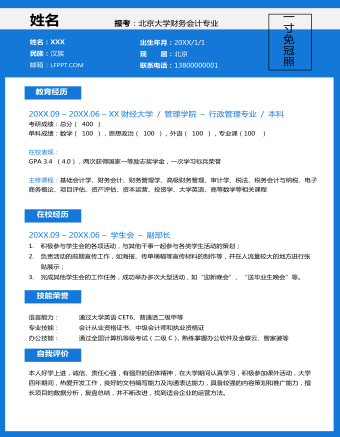
研究生考研复试简历
20XX.09 – 20XX.06 – XX财经大学 / 管理学院 – 行政管理专业 / 本科考研成绩:总分( 400 )单科成绩:数学( 100 ),思想政治( 100 ),外语( 100 ),专业课(100 )在校表现:GPA 3.4 (4.0),两次获得国家一等励志奖学金,一次学习标兵荣誉主修课程:基础会计学、财务会计、财务管理学、高级财务管理、审计学、税法、税务会计与纳税、电子商务概论、项目评估、资产评估、资本运营、投资学、大学英语、高等数学等相关课程
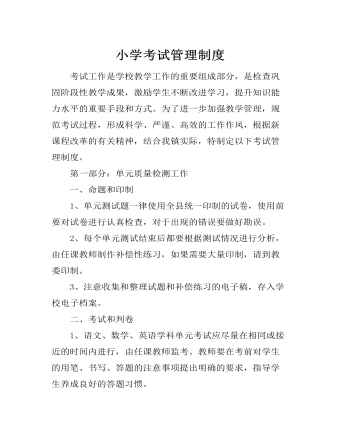
小学考试管理制度
一、命题和印制 1、单元测试题一律使用全县统一印制的试卷,使用前要对试卷进行认真检查,对于出现的错误要做好勘误。 2、每个单元测试结束后都要根据测试情况进行分析,由任课教师制作补偿性练习,如果需要大量印制,请到教委印制。 3、注意收集和整理试题和补偿练习的电子稿,存入学校电子档案。 二、考试和判卷 1、语文、数学、英语学科单元考试应尽量在相同或接近的时间内进行,由任课教师监考。教师要在考前对学生的用笔、书写、答题的注意事项提出明确的要求,指导学生养成良好的答题习惯。 2、在组长的主持下,组内教师要对试卷的答案和可能出现的问题进行充分讨论,在形成统一的意见和评判标准后再进行判卷。 3、单元测试成绩卷面不准出现分数,一律采用等级评价,一般情况按A、B、c、D四个等级评价,不得单独以成绩给学生排名。 三、分析和补偿 1、任课教师要高度重视试卷的讲评工作,不仅帮助学生改正错题,更要指导学生触类旁通,提升对本单元知识的总结和应用。教师还要根据学生考试情况,反思教学、总结经验。 2、任课教师要及时将本班学生考试成绩进行认真分析统计,及时填写《单元检测分析表》,根据分析情况制作补偿练习,由任课教师批改补偿练习。 第二部分:期末质量检测工作 一、命题和印制 1、一般情况下,语文、数学、英语学科的期末考试均采用县教研室小学部统一命题的试卷,特殊情况需学校自行命题时,另行通知。其他学科一般采用镇教研室统一命题的测试题。 2、考试过程中相关责任人要认真做好试题的命制和保密工作,要熟悉学科的《课程标准》、教材和教学要求,了解学生实际情况,对试卷题量、难易程度、题型选择、试卷结构等负有全部责任,,确保命题质量。命题人要写出参考答案和评分标准,以便统一阅卷。

关于考试的国旗下的讲话
尊敬的各位领导、老师、亲爱的同学们:大家好!我演讲的题目是《考试来了,你们准备好了吗?》。同学们,现在又进入期末紧张的复习阶段了,有的同学或许正为即将到来的期末考试而紧张,怎样才能使自己的头脑更聪明呢?据说有一个叫小机灵的小朋友,遇见了一个智慧大师,问:大师,怎样使我明天比今天更聪明呢?智慧大师说:“给头脑充电,明天你就会更聪明!”可是怎么充电呢?大师说了:一要多运动。二要增加营养。三要注意休息。四要手脑并用。所以说你要更更聪明的话,一定不要忘记给大脑充电,不要忘记运动,一定不要忘记给大脑充电,不要忘记运动、营养、休息呀!期末考试马上就要到了,你们准备好了吗?其实考试对于我们并不陌生,经历了考试,我们有了千般经验和教训;经历了考试,我们获得了更多的知识。期末检测是对自己一学期学习情况的一次检验。我们作为新世纪的一代,更应该树立为中华崛起而读书的目标,明确规定历史赋予我们神圣的职责,为了达到这一目标,我们要一步一个脚印地向前迈进,认真做好期末考试的复习,在掌握基本知识的基础上温故知新,拾遗补缸,注意复习注意方法,提高学习效率,争取取得优秀成绩。
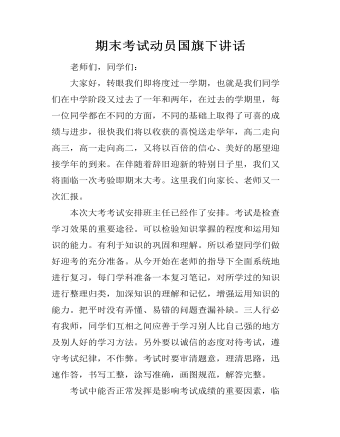
期末考试动员国旗下讲话
老师们,同学们:大家好,转眼我们即将度过一学期,也就是我们同学们在中学阶段又过去了一年和两年,在过去的学期里,每一位同学都在不同的方面,不同的基础上取得了可喜的成绩与进步,很快我们将以收获的喜悦送走学年,高二走向高三,高一走向高二,又将以百倍的信心、美好的愿望迎接学年的到来。在伴随着辞旧迎新的特别日子里,我们又将面临一次考验即期末大考。这里我们向家长、老师又一次汇报。本次大考考试安排班主任已经作了安排。考试是检查学习效果的重要途径。可以检验知识掌握的程度和运用知识的能力。有利于知识的巩固和理解。所以希望同学们做好迎考的充分准备。从今开始在老师的指导下全面系统地进行复习,每门学科准备一本复习笔记,对所学过的知识进行整理归类,加深知识的理解和记忆,增强运用知识的能力。

人教版新目标初中英语七年级上册Can you play the guitar教案
本单元主要是学习情态动词can的肯定句、否定句、一般疑问句,肯定与否定回答,以及特殊疑问句的构成和用法;复习what弓!导的特殊疑问句。本单元主要围绕“加人俱乐部,谈论自己的能力”这一话题,设计了三个任务型活动:任务一是:自己的才艺表演,学习情态动词can的用法;任务二是:自己建立俱乐部,运用情态动词can谈论自己在某一方面的能力、喜好和意愿;任务三是:我能成功,主要是复习巩固谈论各自的爱好和特长的方法。单元知识系统(树)Can you/he/she/you dance? 一Yes,I/he/she/we can./No,I/he/she/we can’t.Can Bill play the guitar?一Yes,he can,but he can’t sing.单元总体目标通过学习情态动词can的用法,使学生能够表达自己在某一方面所具备的才能;能够谈论自己的喜好与意愿;能够为自己成立的各种俱乐部制作海报;会写招聘广告。单元重难点一览重点 难点I.复习词汇:can,play,want2.词汇:guitar, dance, swim,sing, chess, speak, drum,trumpet,violin,play the guitar3.句型:Can you/he/she/you dance?Yes,I/he/she/we can./No,I/he/she/we can’t.Can Bill play the guitar?

人教版新目标初中英语七年级上册How much are these pants教案
个性练习设计 阅读广告:在日常生活中,人们去买东西之前,一般要阅读广告,从广告中获取该商品的一些有用信息,包括价格、性能等。所以给学生提供有些商品的广告或让学生去商店去阅读一些商品的广告,从中获取商品的价格,即可以锻炼学生的阅读能力,又能提高实践能力。 Self Check 教学内容 Self Check(教材P42) 教学目标 知识与能力 复习词汇pant,sock,T-shirt,sweater,shoes,color,black,white,red,green,blue,big,short,long,数字10--31; 学习词汇Zig Zag,clothes,shop,yellow,ask,which;学会谈论服装的价格、颜色、大小和长短;学会填写价格标签。 过程与方法 运用Summarizing和Classifying的学习策略。在复习教学中,运用听写、绘画、互相询问调查与检测等手段,促使学生不断地使用所学内容,从而提高他们灵活运用知识的能力。 情感态度价值观 该部分学习内容主要是复习谈论服装的价格和颜色以及对服装的喜好,能引起学生的共鸣;通过购物的对话练习教学生学会购物时使用的礼貌用语和如何感谢人。

人教版新目标初中英语七年级下册How was your weekend教案2篇
Teaching Goal:1. General aims:Talk about recent past events2. Particular aims:A. Language Focus.Talk about recent past events and think of the past events.B. Language goalsHow was….?It was …What did …do over the weekend?C. Language structures:(1). How was your weekend? I was great. Pay attention to no form.(2). What did you do over the weekend? I played soccer. We went to the beach.D. Useful words and phrases:Words: was, did, went, beach, over, project, test, wasn’t, false, number, geography, spend, week, most, mixture, their, had, little, cook, read, saw, change, everyone, sit, sat, no, anythingPhrases: did one’s homework, played soccer, cleaned my room, went to the beach, played tennis, went to the movies, on Saturday morning, over the weekend, cook … for, what about, do some reading, have a party, talk show, go shoppingE. Grammar language:Present simple past tenseRegular and irregular verbsF. Learning strategies:Tour and holidaysG. Interdiscipinary:H. Emotion and manner:Teaching time: 5 periodsTeaching procedures:Period One教学步骤、时间 教师活动 学生活动 媒体应用Step 1Free talk 3’ Ask some questions like:Who’s on duty today?What’s the weather like? Answer and talk about something.让同学们回答下列问题1. Do you like weekend? (Let some students answer)It takes them three minutes to talk about the question.2. Why do you like weekend? (let the students answer) Most of the students like the weekend此时教师用汉语问:“在周末期间问你干了什么?这句话用英语这么回答?Let the students guess.At last the teacher give them right answer3. What did you do over the weekend?(板书、学习)

人教版新目标初中英语七年级上册What’s this in English教案
一、知识和能力目标本单元的核心教学内容是“认物”。用英语确认周围的常见事物比较符合英语初学者的实际情况。通过本单元教学,使学生运用所学句型,去熟悉周围事物的名称;教学生学会在实际生活中如何确认事物。通过辨认物体,学生学到一些生词,并巩固所学句型。二、过程和方法目标教师要尽量使学生对课文中出现的句型能够熟练上口,这样,学生才能顺利开展比较灵活的对话。教师可以用手势,表情,动作等示意,帮助学生听懂课堂教学内容,但在实际操作中应尽量避免“明知故问”的倾向,应该采用应用性原则;如:遮盖物品、显露局部、辨认物体、完形识别、图形辨认等方法。三、情感态度和价值观目标目标在学生学习过程中的作用至关重要,教师要帮助他们建立起一个切合自己实际的目标,通过渐进的学习以及一点一滴的进步,使他们逐步建立起成功感。成功越多,自信心就越强。

人教版新目标初中英语七年级下册I ’d like some noodles教案
教学过程Step 1: warming-up Sing a song---------“food and drink” Step 2: Revision1 Dictation2 Revise: What kind of noodles would you like?I’d like …What size bowl of noodles would you like?I’d like…Step 3: Presentation1 show pictures of food, ask students say the words.2 Students read the newspaper ad in 3a. Fill in blanks with words in the box. Then read the ad together, the teacher explains some difficult language points.3 Check the answers Step 4 PracticeAsk students to finish 3b in the same way according to 3a. Students read the short passage and fill in the blanks .At last, check the answers.Step 5 productionAsk students to write their own ad for dumplings, noodles, drinks, and other foods they know. Then ask students to read their partner’s ad. Then order food and drink from their partner.Step 6 Home workGroup work – make an ad about “food and drink”

人教版新目标初中英语七年级下册Where is your pen pal from教案
2.1Match the country with the language.Step II Reading3a? let the students read the letter fast and answer the questions.? Let the students ask more questions about the letter as possible as the can.Step III Writing3b.Step IV. Pairwork2cStep V Listening2a, 2bStep V. HomeworkExercises book(1) P3Exercises book (2) P3Period FourStep I . Dictate the words and sentences in Unit1.Step II. Self-checkStep III. Check the answers for Exercises book in the unit.Step IV. Home workRevise and preparation for unit 2.教学反思:通过本单元的学习,学生基本可以谈论人们的国籍,居住城市及其所说的语言,通过书信方式去介绍自己并寻找笔友。但在涉及到国外的一些城市时,学生对这方面的知识相对欠缺,能介绍的城市并不多,也反应出学生课前预习不充分,这跟学生学习条件也有关,大多数学生无法通过网络获取所需信息。因此,在以后的教学中要多指导学生通过计算机网络获取信息,拓宽知识面。

人教版新目标初中英语八年级上册Can you come to my party教案3篇
Step 3 (3b)First, tell the students when we talk about our future plans, we often use: I’m+verb+ing When we talk about what we must do, we use have to. Ask the students to fill in the blanks in 3b. The answers are: shopping, go to see, a test, I’m going, my family. Step 4 (3c)Let the students write an e-mail message to a friend. Say why you can’t visit next. Before the exercise, ask the students to give some possible answers and write them on the blackboard. So the students will feel easy to finish the writing exercise. After they finish it, Let them to correct it in groups first. Each group chooses theirs best one to read in front of the whole class. Step 5 ( planning a party )First read the conversation in the box together. Then ask the students to turn to page 88.Write down everything you have to do next week. Write in all the things you have to do . Ask the students to look at the list. Ask them “What day are you free?” This is when you can have your party. Step 6 (Self check 1 )Let the students to fill in the blanks with the words given. Change the forms of the words if possible. Then make their own sentences. The answers are: visit, playing, have to, study, comeStep 7 (Self check 2)Imagine you are Marie. Read the information and look at your schedule. Write replies to the invitation.

人教版新目标初中英语八年级上册How do you get to school教案2篇
Step Ⅶ Role play ( Work on 1b)1. First ask two students to read the dialogue to the class.Sa: How do you get to school?Sb: Well, I ride my bike to the subway station. Then I take the subway.2. Now work with a partner.Suppose you use two kinds of transportation to get to school \Hangzhou\Beijing... (bus, train, subway, walking, bike, etc.) Tell how you get there. You may use the phrases in 1a.3. Then ask different pairs of students to present their conversations to the class.Step ⅧListening1. Work on 2a(1) First ask students to read the list of information that Thomas wants to know.…where Nina lives.…how far from school she lives.…how long it takes to get to school.…how she gets to school.…what she thinks of the transportation.(2) Tell students what transportation and bus stop mean.bus stop 汽车站 transportation n. 运送;运输Then tell students we'll hear a recording. Please put a checkmark in front of each thing that Thomas wants to know.(3) Now play the recording for students.( Have students pay attention to the sample answer.) (4) Then correct the answers.

人教版新目标初中英语八年级下册What should I do教案2篇
说明:在帮Li Lei提建议的同时,教育学生如何学好英语。第三课时教学目标1. 语言目标:a) 词汇: Original, in style, haircut, the same as.b) 语言结构:My friend wears the same clothes and has the same haircut as I do.2. 能力目标:大多数学生能够谈论自己喜欢哪种服装,提高查找信息的能力。3. 情感目标:学会如何与朋友相处,要有自己对时尚的看法。教学重点掌握一些重要词汇。教学难点学会谈论问题,并能提出书面建议。◆教学突破首先针对Erin的问题,提出个人的建议,模仿2c部分的对话展开双人交际Pair-work;听老师诵读3a部分的信件,并找出LEFT OUT的问题所在;学生完成3b部分的内容,给Left Out提出书面的建议;学以口头形式提出自己目前存在的某个问题,讲给大家听,让同学们给自己提出一个建议,并作笔录;学生两、三个人分成一组,随意性地进行口语交际,谈论P14的第4部分的某个问题,相互交换意见。

人教版新目标初中英语八年级下册How long have you been collecting shells教案2篇
Step Ⅱ Show the new words on the screen and teach the new words. Read the new words to students and ask them to repeat.Step Ⅲ 3aThis activity introduces new vocabulary and provides reading practice using the target language.In this activity first look at the four pictures.T: What can you see in the pictures?Ss: Four snow globes.T: Right. There are four snow globes in the pictures. And what are they?Ss: They are a monster, two polar bears, two penguins and a birthday cake.Write these words on the blackboard: snow globe; monster; polar bear; penguin and birthday cake. Read them to the class and ask students to repeat each one. Make sure students understand each word.Use a computer to show the E-mail message on the screen and read the message to students.Get students to read the e-mail on their own, and then draw lines connecting each snow globe and its description.Correct the answers.AnswersA line should connect each snow globe picture with the words that describe it in the letter.Step Ⅳ 3bThis activity provides writing practice using the target language.First review Activity 2a on Page 47.Then ask students to complete the message according to Activity 2a.Some partial sentences are given to students. Write about one person's collection.When students work, walk around the room checking the progress and offering help as needed.When they finish, ask some students to read their messages to the class.

人教版新目标初中英语八年级下册Would you mind turning down the music教案
Step 4. Group work (4)1. Ask a pair of students to read the dialogue. Say, This activity provides speaking, listening and writing practice using the target language.2. Ask students to complete the work in groups.3. Check the answers with the whole class. 4. Explain some of the language points. Step 5. Word review (Self check 1)1. Ask students to read the words and the phrases given. 2. Fill in the blanks with proper forms of these words to complete the sentences. 3. Check the answers with the whole class. Homework:Do activity 2 on page 57 after class. Period 6Teaching aims: 1. Teach vocabulary words and the useful expressions. 2. Enable the students to learn etiquette in different culture. 3. Help the students learn how to behave politely in public places and in daily life. Teaching procedures:Step 1. RevisionHelp students to review the function of making requests through a free talk. Then lead them to the topic of etiquette. Explain the meaning of etiquette. Or, ask students to look it up in the dictionary. Step 2. Pre-reading (Section 1)1. Ask students to read the picture and make a list with their partner about how many rules of etiquette can be seen being broken.

人教版新目标初中英语九年级上册How do you study for a test教案2篇
内容提示本单元主要内容是学会利用verb十by/with gerund表示方式方法来讨论学习英语的策略,认识自己在学习方面的长处和不足。初步了解现在完成时的结构和用法。现在完成时由助动词have/has+动词的过去分词构成,主要表示过去发生的某一动作对现在仍有影响或造成的后果,常与already,yet,just,ever,never等副词连用。教学目标一、学习目标(Language Goal) 1. Talk about how to study . 学会讨论各种学习方法和策略。2. Find out your suitable learning methods. 找出适合自己的学习方法。 二、语言结构(Language Structures) 1. Verb + by with gerund by+动名词短语 表示“通过…途径,方法” 2. How questions have引导的特殊疑问句 三、目标语言(Target Language) 1. How do you study for tests ? 你是怎样准备考试的?Well , I study by working with my classmates. 哦,我和同学们一起学习。2. Have you ever studied with a group ? 你曾经参加过学习小组吗?Yes , I have . I’ve learned a lot that way . 是的,参加过。通过这种方式我学了许多。